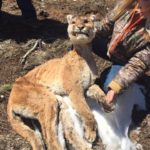The snow was a day old and so, it appeared, were the tracks of the lone wolf. I saw them near the truck and then crossed them again on a high ridge back in the woods. It was travelling as wolves often do: walking with purpose and covering ground. I wondered how far it had gone since it passed this way.
Game was scarce and the snow still deep. The only other tracks I saw were from a few snowshoe hares and a red fox or two. What little moose sign I encountered was many weeks old. A large carnivore in the winter woods must cover a lot of ground just to find its next meal.
I thought about this while looking over an informal report of deer and wolf sightings during the annual northeastern Minnesota aerial moose survey compiled by Mike Schrage, wildlife biologist for the Fond du Lac Band of Lake Superior Chippewa. He said an informal tally of deer and wolves has been kept during the survey for many years, but he began consistently collecting data in 2011. Due to retirements and other staffing changes over the years, no one presently knows what happened to the tallies from earlier years. He stresses, however, that the data is incidental.
“We’re flying a moose survey, not a deer or wolf survey,” he said.
The moose survey, generally flown in January, counts moose visible on survey plots in Cook, Lake and St. Louis counties. Data gathered during the survey is used to derive an annual moose population estimate, as well as the ratio of cows to bulls and the percentage of cows accompanied by calves. This information gives biologists some insight as to the overall health of the moose herd.
Schrage has been flying the moose survey, which is a coordinated effort between state and tribal wildlife managers, since 1996. Back then, the survey was conducted with fixed-wing aircraft flying by compass and biologists using paper maps, pencils and data sheets. Nowadays, survey crews use a helicopter, navigate with GPS and enter the data on laptops. They can also use radio-collared moose to check the veracity of their visual observations.
The deer and wolf data is relevant as well. Deer carry a brain worm parasite fatal to moose and wolves include moose in their diet. Schrage said deer do not turn up in most of the survey plots, but do show up in known whitetail wintering areas, such as along the North Shore of Lake Superior and in the vicinity of Ely and Tower. A few wolves show up across the survey area. Schrage says the average pack size is consistent with what is found in Minnesota wolf surveys; groups of about four or five individuals.
Some places within the moose range that once held wintering whitetails now have few, if any deer. These are places where wintering deer were supported by artificial feeding and the feeding came to an end. Schrage shared papers from earlier wolf and deer research projects that made note of these locations and the number of deer they supported. The papers also note that artificial feeding disrupts natural winter migration patterns and the use of traditional wintering areas. I don’t know if there has been any research of whether winter feeding bolsters local deer populations and, if it does, what affect it may have on moose in the vicinity.
Schrage has been flying the survey long enough to see the trees grow. Newly disturbed forest areas, whether created by wildfire or logging, create excellent moose habitat, because the animals browse on the regenerating saplings. He noted moose numbers in some locations have declined as the forest aged. One place he has seen this occur is the Pine Mountain and Lima Mountain area along the Gunflint Trail.
On the flip side, during the past decade large wildfires in and near the BWCAW are now providing excellent moose habitat. Biologists are flying some annual survey plots within the burns just to monitor the response of moose. Currently, some of the highest moose densities are in the vicinity of burns. This suggests that habitat improvements could lead to more moose in the northeast.
“Certainly, there are other issues related to moose,” Schrage said, “But we’ve got to have habitat.”
Less quality habitat, simply an older forest, means the northeast can support fewer moose than it once did. He said the country north of Isabella, once prime for moose, now contains many maturing pine plantations. The conifers may provide cover, but little in the way of food for moose. Significantly less logging is occurring in the northeast than there was 20 or more years ago, especially on Superior National Forest lands. There is also a greater emphasis on planting pines in harvested areas, rather than managing for naturally regenerating aspen/birch forests. Both of these factors are working against moose habitat. Due to land management strategies and a reduced demand for forest products, opportunities to improve moose habitat appear to be limited for the foreseeable future.
A man who loved moose
It was a surprise to learn last week of the passing of Larry Schanno of Finland, where he owned Our Place Restaurant, a popular hangout for snowmobilers, off-roaders, hunters, anglers and just everyone who enjoys the backcountry of Lake County. The restaurant contains a collection of moose antlers Larry found, some of which are carved with scenes. He was a serious shed antler hunter long before the activity became popular.
In recent years, he became better known for his kindness to the residents of the Silver Bay Veterans Home. He had great respect for anyone who, like his own father, served in the military. Once a week, he treated Veterans Home residents to a free lunch at the restaurant. Nearby, he owned land where he built a wheelchair-accessible pond and stocked it with trout. During the summer, the men from the Veterans Home went fishing there. Some even hunted deer on the property.
Larry was a reader of this column and he wasn’t shy about saying that he didn’t always agree with what he read here. But more importantly, he was a guy with whom you could agree to disagree. He knew a lot about moose and wolves and the woods. I always enjoyed my conversations with him. And I’ll miss having more of them.
[td_insert_ad]




